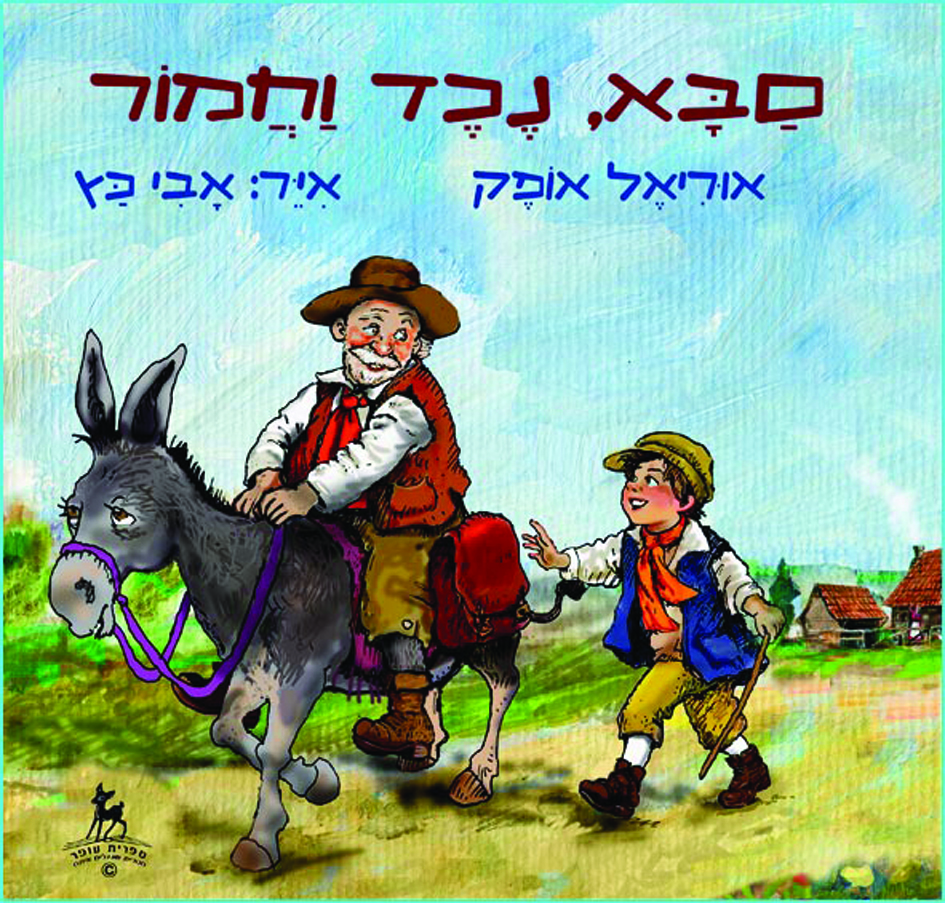Дед, внук и осел
Уриэль Офек
Дед, внук и осел отправились в путь. Дедушка едет на осле, а внучек идет рядом с ним. Это не нравится прохожим, и они предлагают деду и внуку разные способы, как им идти вместе. В конце концов, чтобы угодить всем, дед и внук водружают осла себе на плечи!
На русском языке мы знаем эту восточную притчу в интерпретации Самуила Маршака. Его слова даже переложены на музыку Дмитрием Кабалевским:
Мельник, мальчик и осел
Мельник на ослике ехал верхом.
Мальчик за мельником плёлся пешком.
– Глянь-ка, – толкует досужий народ,
Дедушка едет, А мальчик идёт!
Где это видано? Где это слыхано? –
Дедушка едет, А мальчик идёт!
*
Дедушка быстро слезает с седла,
Внука сажает верхом на осла.
– Ишь ты! – вдогонку кричит пешеход. –
Маленький едет, а старый идёт!
Где это видано? Где это слыхано? –
Маленький едет, а старый идёт!
*
Мельник и мальчик садятся вдвоем –
Оба на ослике едут верхом.
– Фу ты! Смеется другой пешеход. –
Деда и внука скотина везёт!
Где это видано? Где это слыхано?
Деда и внука скотина везёт!
*
Дедушка с внуком плетутся пешком,
Ослик на дедушке едет верхом.
– Тьфу ты! – Хохочет народ у ворот. –
Старый осёл молодого везёт!
Где это видано? Где это слыхано? –
Старый осёл молодого везёт!
На иврите эта притча известна в поэтической интерпретации известного писателя Уриэля Офека. Она в забавной форме показывает, как трудно угодить всем. После чтения посмеемся вместе над этим рассказом и над другими шутками к празднику Пурим, ведь сказано "Пришел Адар – пришло веселье." (Детские садики получат книжку в месяце Адар - в марте). А также выучим выражение: "Возникла последней, но задумана первой".
Адлояда: смех и юмор
Что может рассмешить нас? Обычно это простые события, представленные в необычном ракурсе. Дети смеются над тем, что случается с ними или с их друзьями и переворачивает их представление о мире. Пурим – это один день в году, когда мы празднуем этот переворот.
Юмор открывает перед нами возможности свободного творческого мышления. Это приятный способ учиться смотреть на себя со стороны и исправлять свои ошибки.
В нашем рассказе каждый шаг дедушки и внука подвергается критике. Попытки справиться с критикой доводят их до абсурда. так что в конце концов не понятно, кто же там "осел".
Еврейский юмор
Еврейский юмор знаменит тем, что это смех над собой. Каковы шутки, которые евреи рассказывают евреям, и о чем они? Конечно же о том, что случается с евреями. Хотя часто в этих шутках говорится о бедах, обычно в них есть сочувствие и понимание того, что происходит в жизни людей. Гершеле, Джоха и хелмские мудрецы сопровождают еврейский народ и вызывают улыбки даже в трудные времена.
У вас есть интересная шутка? Пришлите ее и нам тоже!
Занятия в кругу семьи
·В нашем рассказе есть действия, которые не соответствуют общепринятым, противоречат им и вызывают смех. Можно поискать ихна иллюстрациях вместе с детьми.
· Дети могут нарисовать или сфотографировать из книжки фигурки дедушки, внука и осла и приклеить их на маленькие магниты.Отправьте эти фигурки в маленькое"путешествие" по холодильнику или двери: пусть то один скачет, то другой тащит...
·Вместо того, чтобы ехать на ослике, дедушка и внук взваливают его себе на плечи! Выберите какую-нибудь вещь и попробуйте ее использовать не по назначению. Соберите в коробку разные предметы, знакомые детям. Каждый участник игры выбирает предмет и предлагает разные способы его использования.
·Кто сможет не рассмеяться? Каждый участник по очереди говорит другому "И-а, и-а, мой ослик" и старается его рассмешить. А его партнер старается не рассмеяться.
·Бабушка ждет дедушку и внука домой. Она, конечно, спросит: "Ну, как вы погуляли?" Предложите детям описать, что дедушка и внук ей расскажут.
· "Этот смешной ребенок". Расскажите детям какие-нибудь смешные случаи из жизни семьи.
Возникла последней, но задумана первой
"Возникла последней, но задумана первой" – это слова из пиюта "Леха доди", который сочинил 400 лет назад в Цфате раби Шломо Элькабец. В пиюте говорится, что Бог создал мир за шесть дней, зная заранее, что в конце недели настанет Суббота, и что она станет венцом творения.
Выражение "Возникла последней, но задумана первой" может научить нас сначала подумать и спланировать, а потом сделать (сравните русскую пословицу "Семь раз отмерь, один раз отрежь"), ведь у того, кто знает, куда он хочет прийти, будет по крайней мере меньше трудностей по дороге, он не будет принимать каждый совет, так как будет знать, что хорошо именно для него.
·Когда осел знает дорогу, он не собъется с нее и уверенно привезет ездока туда, куда нужно. Рассмотрите выражение на морде нашего осла. Как вы думаете, что он чувствует, когда слышит эти странные советы?
·Все прохожие дают деду и внуку советы, и они совсем запутываются. Но в конце дед говорит: "Мы не сможем всем угодить". Побеседуйте с детьми на следующие темы: Кто нас хорошо знает и может дать дельный совет? Чье мнение влияет на нас меньше? Когда мы должны стоять на своем мнении и не подчиняться мнению друзей?
·Иногда кажется, что то, что говорят другие, важнее того, что думаем мы. Спросите у детей, случалось ли им прийти к какому-либо решению самим и не пойти на поводу у друзей, подбивавших их на плохие поступки.
·От начала и до конца. Спланируйте дорогу дедушки, внука и осла от начала и до конца и проведите их фигурки от городских ворот и до дома. Можно сделать это в виде игры, используя лего, кубики и даже подушки.





